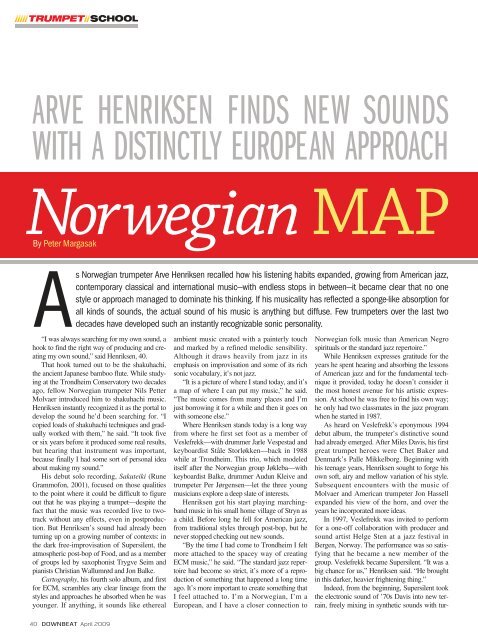You also want an ePaper? Increase the reach of your titles
YUMPU automatically turns print PDFs into web optimized ePapers that Google loves.
ARVE HENRIKSEN FINDS NEW SOUNDS<br />
WITH A DISTINCTLY EUROPEAN APPROACH<br />
Norwegian MAP<br />
By Peter Margasak<br />
As Norwegian trumpeter Arve Henriksen recalled how his listening habits expanded, growing from American jazz,<br />
contemporary classical and international music—with endless stops in between—it became clear that no one<br />
style or approach managed to dominate his thinking. If his musicality has reflected a sponge-like absorption for<br />
all kinds of sounds, the actual sound of his music is anything but diffuse. Few trumpeters over the last two<br />
decades have developed such an instantly recognizable sonic personality.<br />
“I was always searching for my own sound, a<br />
hook to find the right way of producing and creating<br />
my own sound,” said Henriksen, 40.<br />
That hook turned out to be the shakuhachi,<br />
the ancient Japanese bamboo flute. While studying<br />
at the Trondheim Conservatory two decades<br />
ago, fellow Norwegian trumpeter Nils Petter<br />
Molvaer introduced him to shakuhachi music.<br />
Henriksen instantly recognized it as the portal to<br />
develop the sound he’d been searching for. “I<br />
copied loads of shakuhachi techniques and gradually<br />
worked with them,” he said. “It took five<br />
or six years before it produced some real results,<br />
but hearing that instrument was important,<br />
because finally I had some sort of personal idea<br />
about making my sound.”<br />
His debut solo recording, Sakuteiki (Rune<br />
Grammofon, 2001), focused on those qualities<br />
to the point where it could be difficult to figure<br />
out that he was playing a trumpet—despite the<br />
fact that the music was recorded live to twotrack<br />
without any effects, even in postproduction.<br />
But Henriksen’s sound had already been<br />
turning up on a growing number of contexts: in<br />
the dark free-improvisation of Supersilent, the<br />
atmospheric post-bop of Food, and as a member<br />
of groups led by saxophonist Trygve Seim and<br />
pianists Christian Wallumrød and Jon Balke.<br />
Cartography, his fourth solo album, and first<br />
for ECM, scrambles any clear lineage from the<br />
styles and approaches he absorbed when he was<br />
younger. If anything, it sounds like ethereal<br />
40 DOWNBEAT April 2009<br />
ambient music created with a painterly touch<br />
and marked by a refined melodic sensibility.<br />
Although it draws heavily from jazz in its<br />
emphasis on improvisation and some of its rich<br />
sonic vocabulary, it’s not jazz.<br />
“It is a picture of where I stand today, and it’s<br />
a map of where I can put my music,” he said.<br />
“The music comes from many places and I’m<br />
just borrowing it for a while and then it goes on<br />
with someone else.”<br />
Where Henriksen stands today is a long way<br />
from where he first set foot as a member of<br />
Veslefrekk—with drummer Jarle Vespestad and<br />
keyboardist Ståle Storløkken—back in 1988<br />
while at Trondheim. This trio, which modeled<br />
itself after the Norwegian group Jøkleba—with<br />
keyboardist Balke, drummer Audun Kleive and<br />
trumpeter Per Jørgensen—let the three young<br />
musicians explore a deep slate of interests.<br />
Henriksen got his start playing marchingband<br />
music in his small home village of Stryn as<br />
a child. Before long he fell for American jazz,<br />
from traditional styles through post-bop, but he<br />
never stopped checking out new sounds.<br />
“By the time I had come to Trondheim I felt<br />
more attached to the spacey way of creating<br />
ECM music,” he said. “The standard jazz repertoire<br />
had become so strict, it’s more of a reproduction<br />
of something that happened a long time<br />
ago. It’s more important to create something that<br />
I feel attached to. I’m a Norwegian, I’m a<br />
European, and I have a closer connection to<br />
Norwegian folk music than American Negro<br />
spirituals or the standard jazz repertoire.”<br />
While Henriksen expresses gratitude for the<br />
years he spent hearing and absorbing the lessons<br />
of American jazz and for the fundamental technique<br />
it provided, today he doesn’t consider it<br />
the most honest avenue for his artistic expression.<br />
At school he was free to find his own way;<br />
he only had two classmates in the jazz program<br />
when he started in 1987.<br />
As heard on Veslefrekk’s eponymous 1994<br />
debut album, the trumpeter’s distinctive sound<br />
had already emerged. After Miles Davis, his first<br />
great trumpet heroes were Chet Baker and<br />
Denmark’s Palle Mikkelborg. Beginning with<br />
his teenage years, Henriksen sought to forge his<br />
own soft, airy and mellow variation of his style.<br />
Subsequent encounters with the music of<br />
Molvaer and American trumpeter Jon Hassell<br />
expanded his view of the horn, and over the<br />
years he incorporated more ideas.<br />
In 1997, Veslefrekk was invited to perform<br />
for a one-off collaboration with producer and<br />
sound artist Helge Sten at a jazz festival in<br />
Bergen, Norway. The performance was so satisfying<br />
that he became a new member of the<br />
group. Veslefrekk became Supersilent. “It was a<br />
big chance for us,” Henriksen said. “He brought<br />
in this darker, heavier frightening thing.”<br />
Indeed, from the beginning, Supersilent took<br />
the electronic sound of ’70s Davis into new terrain,<br />
freely mixing in synthetic sounds with tur-

















